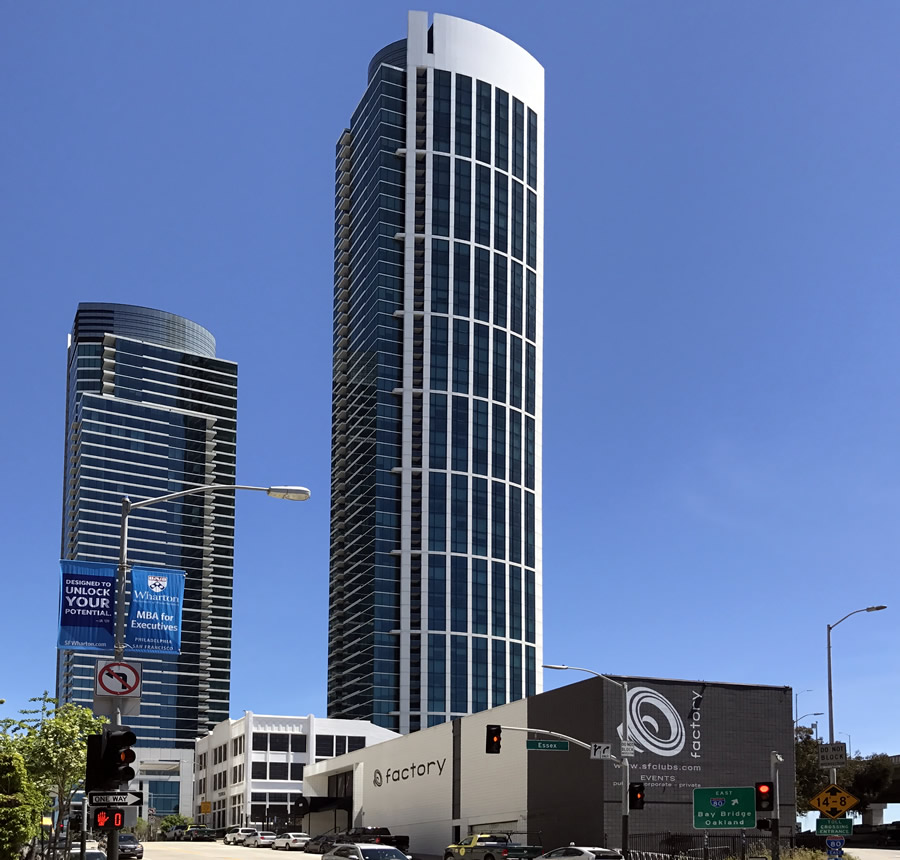While not nearly as serious as the lawsuits related to the sinking Millennium Tower, a lawsuit seeking damages for the “premature and unreasonable deterioration” of the 55-story tower at 425 1st Street known as One Rincon Hill has been filed by the homeowners association in San Francisco’s Superior Court.
According to the all too common construction defect suit, identified problems include balcony sealant failures, broken balustrade glazing and a curtain wall system that is allowing water to get inside.
Keep in mind that the cloud of litigation can impact the ability to refinance or secure a purchase loan. And with One Rincon Development, Lendlease Construction and others having been named as defendants, a case management conference has been scheduled for September.

Build condos and eventually you will be sued by the HOA for construction defects. This is built into the cost model for condo developers.
I don’t think HOAs sue for fun. Litigation is far from enjoyable and costly for everyone involved. Or, so I’ve heard.
They don’t intend to litigate. HOAs sue because if you do not prior to the expiration of the 10 year statute of limitations the HOA members can technically sue the president of the HOA for not protecting their rights. Therefore, the HOA files a lawsuit naming every entity associated with the development of the project and each one settles for a cost that will be far less than litigation, but still unfairly high for architects, contractors and developers that acted within the standard of care for their profession.
The fact that Skirunman points out, that this is built into the cost model for developers, contractors and architects is accurate, but it does not make it right.
If there were tort reform to stop this ridiculous industry and keep lawsuits to the instances where negligence occurred, it would make projects more profitable, which would increase development and maybe, just maybe help resolve the housing shortage. The same thing happens with condos in Colorado and they are close to resolving the issue.
I don’t think Skirunman has any data to back up his theory. I don’t believe it. He’s just speculating.
When did One Rincon complete? About ten years ago. They’re due for the pro forms lawsuit. Seems like there should be a better way.
i was about to say the same thing, we’re getting close to the 10 year mark… hope they had wrap insurance
You’d think that the construction contractors industry would have discovered the concept of quality control by now. The percentage of new construction units where, for example, the roof starts leaking shortly after project completion seems pretty high. Admittedly anecdotal.
In a boom time, buyers buy anything just to get a toehold on the market. And savvy sellers know to get out quickly while the getting is good. Same as waving inspections and contingencies for SFR’s.
I really doubt this suit would be enough for lenders to stop lending on this building. It isn’t leaning or crumbling and as was previously mentioned this type of litigation happens with many, many larger developments. Maybe some out of state lenders would be put off enough when they see that boxed checked?
When I was looking to buy, banks wouldn’t write mortgages for buildings undergoing SB800 litigation (except First Republic, 30% down ARM only)
HOAs sue as a last resort because in doing so they have effectively lowered the resale value of the condos owned by the members of that HOA because they have made problems really really public.
Not in my experience. If an HOA can get defects fixed for free (or reduced cost), plus perhaps cash on top of that, it would be dumb not to.
I have a unit in a building that settled a suit. It meaningfully benefitted all of the owners/residents in terms of the physical property and resale values. While the suit was pending there was never any negative impact.
The developer needs the HOA to sue so they can use their insurance. Happens with almost every condo at the ten year point.
Yeah, is this just under SB800? Looks to me like this is pretty standard.
How does SB800 relate here?
It’s always the balconies.
That or the windows.
So so true.
There’s always some smartass attorney on the HOA who thinks he’s going to get his condo for free. This is why many architects don’t do condos.
I guess their 10 year warranty is set to expire soon.
Is there a copy of the complaint available?
One can be made available by calling the HOA’s law firm of Dewey, Cheatem & Howe.
I wonder if Rincon Tower 2 (The Harrison) will face similar lawsuits?
Is the Pope Catholic?
All housing towers in this area should face defect lawsuits as long as the DTX is not completed and funded to the finish line. Incomplete construction clause…..
Why don’t we hear about this sort of problem in office buildings?
If you look at the specifics of this case, you’ll see one reason: office buildings don’t (usually) have balconies…and discontinuities in a facade introduced by such seem to be a big cause of failure. And of course office buildings are not usually condoed, so you’re going to see fewer litigants involved > less publicity.
But office building litigation isn’t unknown.
We had to sue at the 10 year point – roof and windows – many windows were either upside down, installed w/o sealant, or (like mine) both – leading to water intrusion and mold. Incompetent / negligent construction wasn’t hard to prove.
From The L. A. Times, two weeks ago (emphasis mine):
It seems to me that if “Incompetent / negligent construction” is indeed rampant, it’s not too hard to figure out why.
Standard practice. Under California law I believe you have 10 years to file a construction defect suit. Just about every HOA files right before the deadline if they haven’t already.